Truly, I’ve never seen awareness of a travel destination change so rapidly as with Albania. From a cult favorite among in-the-know backpackers to getting seriously hyped as the ‘next’ Greece or Croatia… it all seems to have happened in a blink.
When I told people I was going to travel in Albania just a couple of years ago, the most common response was something along the lines of “uhh, what is an Albania?”.
Now, the one reaction I get is “oh yeah! I’d LOVE to go there!”.
BUT… as much as Albania has flooded everyone’s social media feeds, the reality is that still few have actually been. In this guide I want to give you the on-the-ground perspective, so that you know what to expect and can truly experience the best of Albania.
While the online hype is real, you’re not too late to discover Albania. I first visited in 2021 before it truly grabbed the spotlight. But even when revisiting in 2025 after hearing about Albania’s impressive tourism growth statistics, it was noticeably quiet. Even at the start of high season in July I saw very few crowds to speak of. For now, Albania as a whole still remains a hidden gem.
Mind you, Albania is still in the early stages of development and some aspects can be challenging (depending on your travel experience). If you want to know what Albania is really like and how to plan your trip properly, you’ve come to the right place.
What I love about Albania
The first thing I want to dive into in this Albania travel guide is that it’s a little less polished than other Mediterranean destinations. You’ll find fewer slick resorts and picture-perfect tourist towns — but a lot more authenticity.
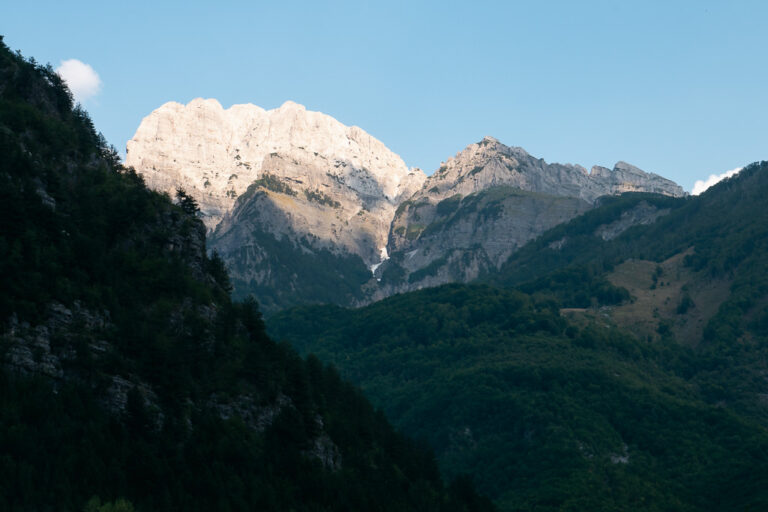
It’s still the perfect place to escape the crowds typically found elsewhere in Europe. While still developing, infrastructure is improving, making the country more accessible.
You may have to travel around using its motley fleet of unofficial minibuses and not every transport connection is always 100% clear, but the roads are increasingly in good shape.
The country certainly has a gorgeous coastline, racking up all those views and likes online, but there is so much more to love about this small Balkan country. What captivated me about Albania (I simply had no idea) is its unique culture and history.

For starters, the Albanian language is one of a kind, totally unconnected to any other European language. Although most Albanians are agnostic, it’s one of the few Muslim majority countries in Europe, giving it a subtly different vibe. It’s also a country that was essentially known as the North Korea of Europe for a long time in its recent history.
Yes, that’s right. Albania used to be (loosely) compared to North Korea.
During the decades under communist dictatorship, Albania was virtually cut off from the rest of the world. Although it was communist, it actually broke off relations with the USSR and was not part of the Soviet bloc.
Albania even had some serious beef with neighbouring Yugoslavia, didn’t care much for Greece, Italy or the West in general, and became almost entirely isolated on the global stage. This resulted in putting its history on a completely separate track.
Until the mid-1980s, Albania was run by a paranoid dictator, who ordered the construction of hundreds of thousands of bunkers — a jaw-dropping project that utterly drained the country’s resources. At peak, there were around six bunkers for every square kilometre.
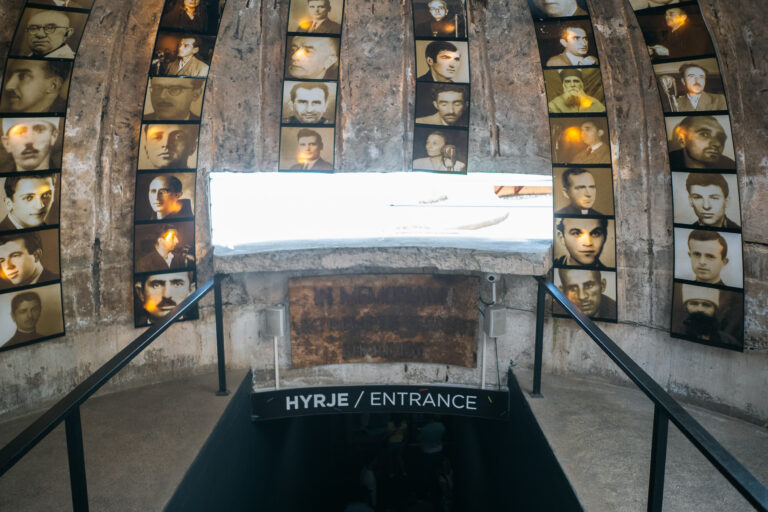

In Tirana, you can descend into some of these bunkers to learn more about these strange and oppressive times — something I highly recommend doing.
But Albania also offers plenty of ancient history as well, having been at crossroads of old empires: the Ottoman, Byzantine, Roman Empire, and others. Architecture from the Ottoman era is especially well preserved in the UNESCO-listed towns of Berat and Gjirokaster.

The nature experiences in Albania are also superb. I think this is secretly one of the best reasons to visit Albania. I loved the (mostly uncrowded) hikes through the Albanian Alps and emerging ecotourism hubs such as Permet, which I’ll dive into later.
The cuisine is another highlight, bringing together influences from the Balkans and Turkish food. You’ll readily find things like kofte (herbed meatballs) and byrek (flaky pastry with fillings like cheese or spinach), as well as various stews, skewers, and stuffed vegetables.

Finally, while not the main reason to visit, Albania is also delightfully affordable. You probably won’t pay more than 1 EUR for an americano in a local cafe. Good meals can easily be had for under 10 EUR and fancy cocktails in the trendy capital hover around 7 EUR.
This affordability is great icing on the cake. (Beware though: certain places aimed at rich Albanians, including Ksamil beach, do have highly elevated prices.)
Today, Albania is a democracy with a growing economy and a major focus on joining the EU. As a travel destination it’s still a bit of a diamond in the rough, but I think both backpackers and increasingly mainstream tourists will find so much to love here.
Reality check: is Albania like the Maldives or Thailand?
Okay, now before you pack your bags, I still need to add a few asterisks. As much as I’m a fan of travelling in Albania, I do need to de-hype it in some respects.
Let me level with you: Albania is actually not a tropical paradise. (Cue sounds of collective gasps, falling cutlery, a person fainting in the back — yes, I said it.)
You might actually see a lot of comparisons online to the Maldives or Thailand but know this is just clever marketing! This does not reflect what Albania, a Mediterranean country, is really like.
The coastal town of Ksamil is a huge hit on Insta and TikTok and is most often compared to the Maldives. The waters here are crystal clear, but what’s never shown are the edge-to-edge covering of beaches with lounge chairs, the jumble of jet skis, or the murderous prices even for a basic cocktail that will have even Western travellers blink twice.
Ksamil is highly overcommercialised and overrated — for me, at least, it doesn’t even rank in my top 10 for Albania. Clever framing made it go hyper-viral but it’s not quite what it seems!

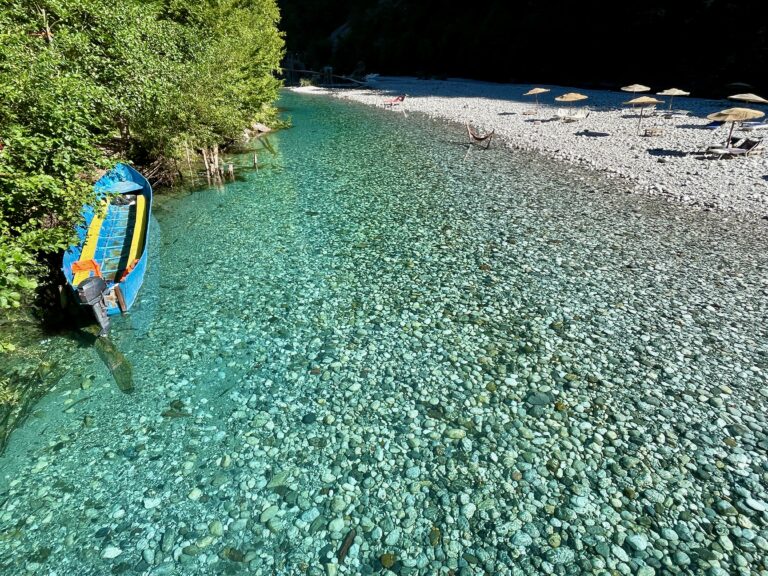
Shala River in the Albanian Alps with its crystal-clear waters and wooden longtail-like boats looks almost like Krabi in Thailand from a certain angle. It’s beautiful and I loved visiting as part of a loop via the Accursed Mountains. However, you should know the waters are actually glacial meltwater. It may be perfect for an ice plunge (if that’s your thing), but it’s much closer to an arctic experience than to Thailand!
My advice is to go to Albania because it’s Albania, not because of silly comparisons based on superficial appearances.
Read on as I tell you about the real Albania, which includes many beautiful beaches as well as plenty of cultural highlights.
Some amazing things to do in Albania
Where to go in Albania
Let me give you some high-level pointers for your trip research to start with. In my two trips, I managed to visit nearly all of the common tourist destinations in Albania, plus a few off-the-beaten-path corners.
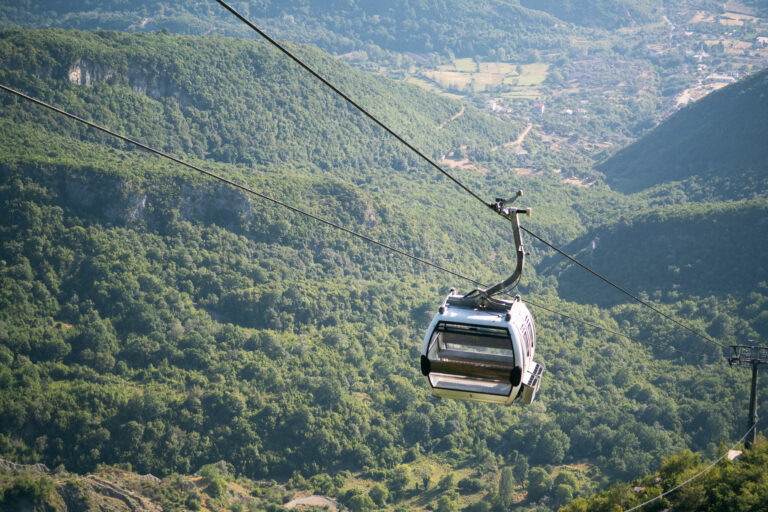
A not about Albanian place names: The Albanian language has two variations for every place name. E.g. The city Shkodër is also known as Shkodra. Tiranë is also Tirana. Himarë is also spelled Himara. I end up using them fairly interchangeably here.
Where to go for beaches
You’ll find local beach places all over the coast, but most international tourism focuses on the mountainous ‘Albanian Riviera’ in the south, running more or less from the city of Vlora to the border with Greece.
Himara
Himara is my go-to for somewhere low-key but lively on the Albanian Riviera. There are plenty of restaurants, bars, and a few beach clubs but nothing too over the top.

If you’re a backpacker then Himara is the perfect spot for you — there are many hostels to choose from (I love Himara Hostel) and prices are far more reasonable than in overhyped Ksamil. I also recommend Himara to families looking for a chill beach stay because the city is easygoing and kids-friendly.
The mountainous coastline around here with its scenic cliffs and tucked-away bays is by far my favorite area. The city itself has two main beaches and there are another dozen or so within a 30-minute drive range. Himara is the sort of place that independent travellers will especially love, but luxury-seekers expecting polished resorts may want to look elsewhere.

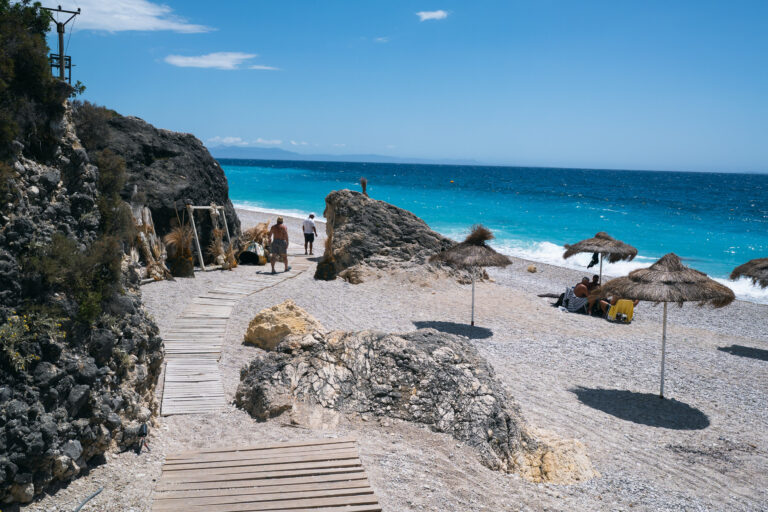
Saranda
Saranda is my second choice for the southern beaches. The town is admittedly a bit cluttered — as many travel guides point out — but its location around a wide bay is genuinely attractive.
It’s just a 20-minute ferry from Corfu in Greece (with its many cheap flight connections) making it the easiest-to-reach hub around here. Day trips to Insta-famous Ksamil are possible from Saranda.
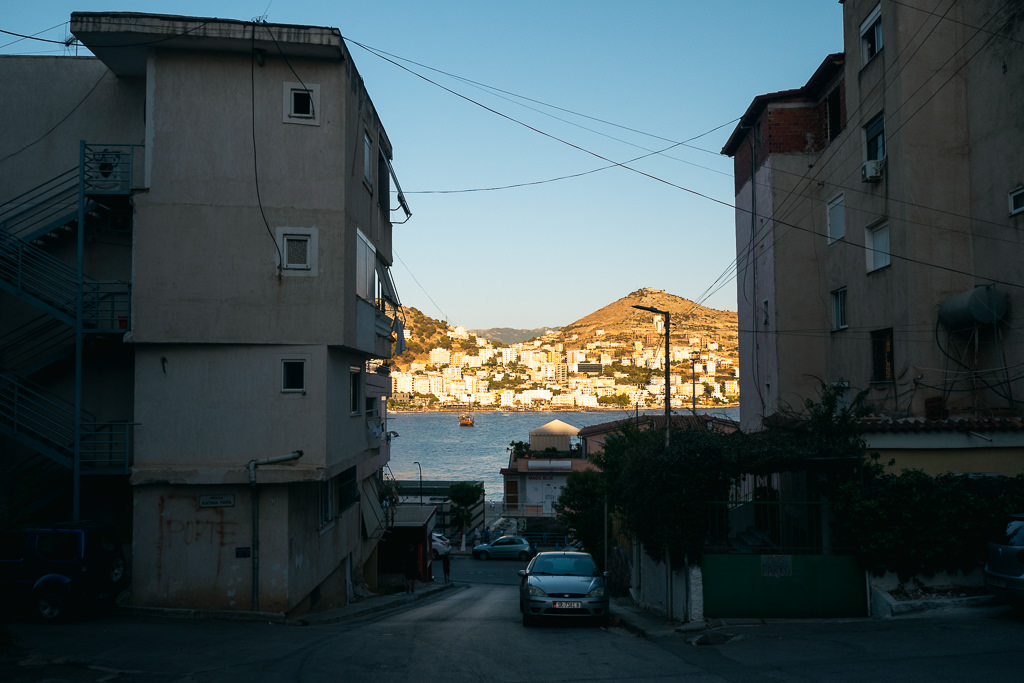

Dhërmi
You might find totally opposite descriptions of Dhermi and that’s because it has two completely distinct parts:
- Old Town (Upper Dhermi) – A village with stone houses with blue frames where you’ll often hear no noise except for some church bells. It almost has a Greek vibe, which makes sense when you learn there is a significant Greek minority population around here. Many properties were still under renovation when I visited in 2025, but I expect this will become a perfect spot for couples wanting to stay in a cute and dreamy place. You’ll have to take taxis or buses to reach the beaches.
- Lower Dhermi – In total contrast to the Old Town, it’s a hugely developed modern beach club and resort hotel zone. Go here for a more polished resort or holiday villa experience or if you love to party. Dhermi attracts a lot of young (Albanian) travelers and international tourists looking for nightlife and electronic music.

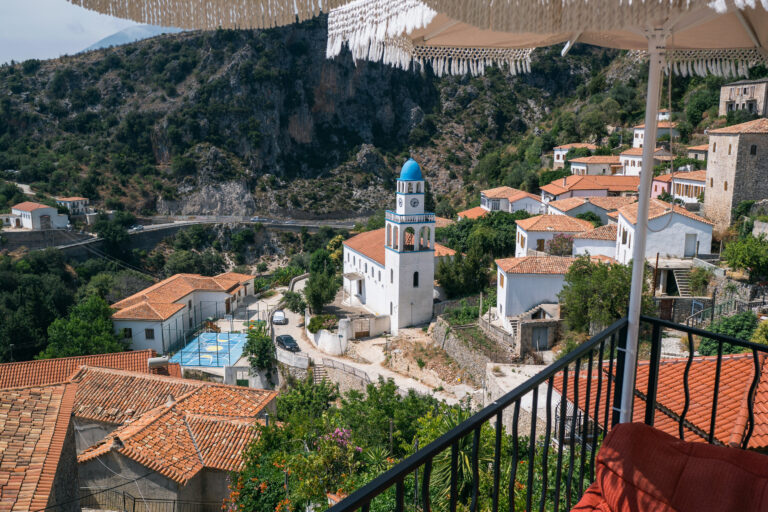
Vlora
A coastal city home to a major port and a dense collection of high-rise hotels, offering long stretches of city beach lined with wide boulevards. With the new Vlora airport coming online in 2026, this will surely develop into a major hub. (Jared Kushner has also invested more than $1bn to build a luxury resort on a nearby island.)
I still consider Vlora more of a transit hub as I prefer the ‘Albanian Riviera’ further south, but for larger-scale hotels or resorts & spas, I would start my search here.
Some really cool things to do here are a day trip out to Sazan Island and the Blue Cave.
Vlora’s a good launchpad for a few wild day trips — craggy cliffs, secret coves, and a stretch of coast.
This tour on GetYourGuide takes you to Sazan island, Haxhi Ali Cave, and the wild Karaburun Peninsula—all while cruising clear Albanian seas, snorkeling, soaking sun-drenched wild beaches, and hearing local stories from the skipper
Where to go for culture & history
If you’re looking for cobbled streets and charming Ottoman-era architecture then two historical cities, both UNESCO World Heritage sites, stand out.
Berat
Nicknamed the “city of a thousand windows”, this well-preserved Ottoman city has numerous whitewashed houses tightly stacked on a hillside.
It’s highly picturesque and climbing to the top will reward you with expansive valley views and lets you explore the remains of a 13th century Byzantine-era castle.
However, the city is a bit limited in other activities, so I recommend Berat as a day trip from Tirana or a one-night stay. For a bite-size experience in a historical city, Berat is the best choice.
see price & details here
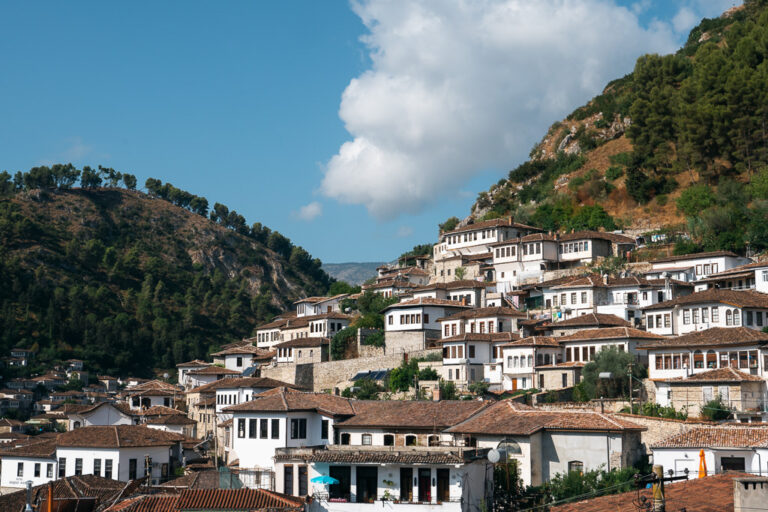
Gjirokaster
This southern city also has plenty of Ottoman houses and a hilltop castle, but it has a bit more going on than Berat. Several small museums are worth a visit, including several ancient merchant houses from Ottoman times.
I also loved using Gjirokaster as a base for exploration, in part with the help of a brilliant off-the-beaten-path jeep tour run by the Stone City Hostel.
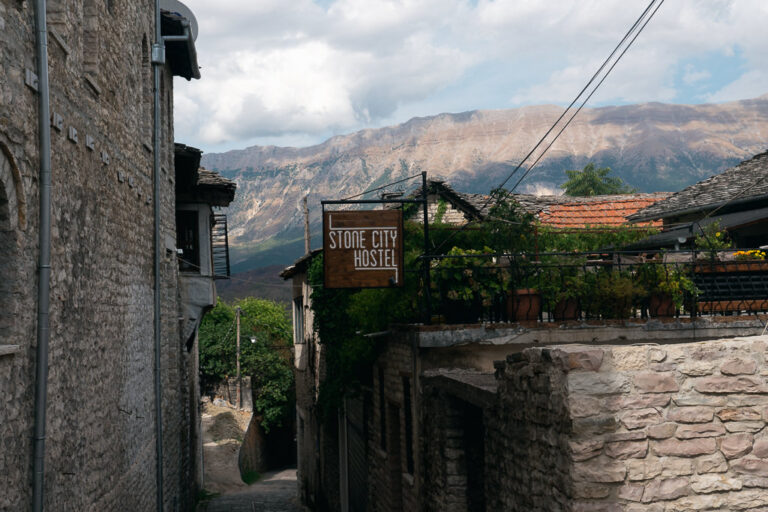
The current top result on Google for Gjirokaster says it’s “nothing special” but I personally disagree; there’s plenty to see and do here, and it deserves at least 2 nights. (Being a slow traveller, I stayed 4 nights, but that might be a bit too long.)
If you’re looking for history and Medieval charm, Gjirokaster is my top pick. You’ll find more about this town in my in-depth guide.
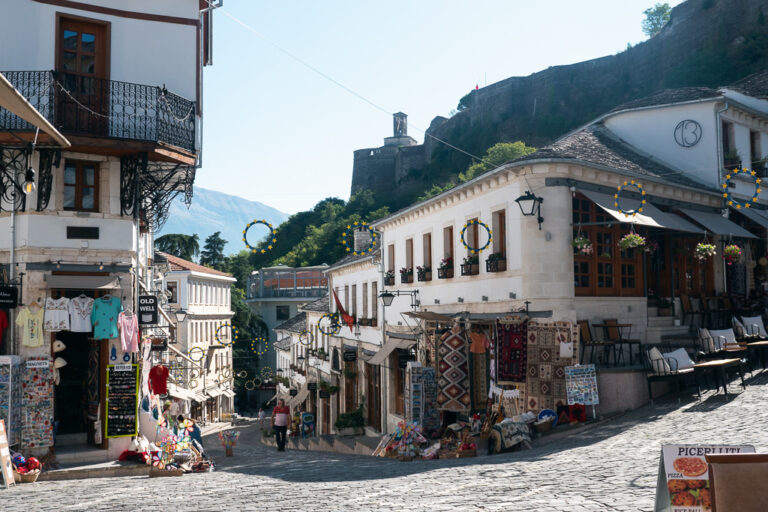
Where to go for nature
There is beautiful nature all over Albania, but there are two hubs in particular I want to point out.
First, if you love hiking then you need to get to the Albanian Alps in the north — also intimidatingly called the Accursed Mountains (but don’t worry, instead of curses it will surely put a spell on you with its jagged peaks and scenic waterfalls!).
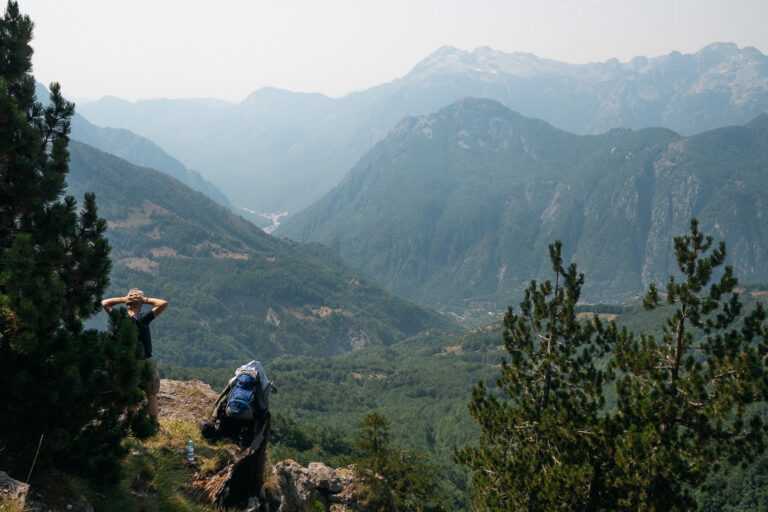
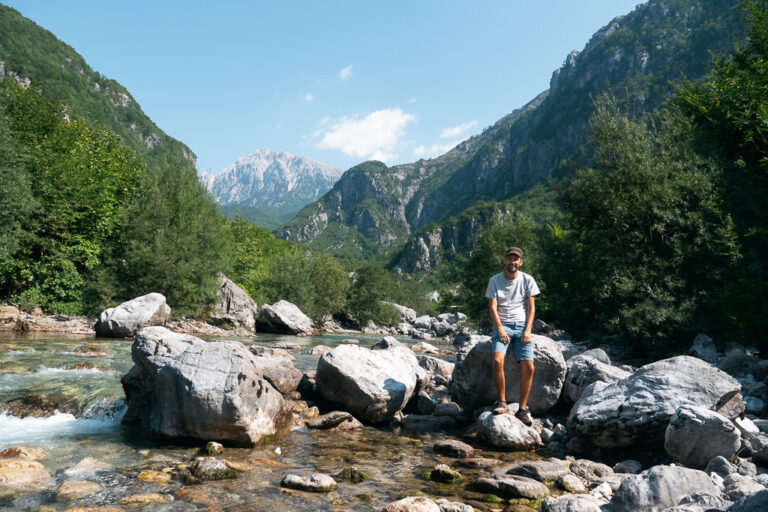
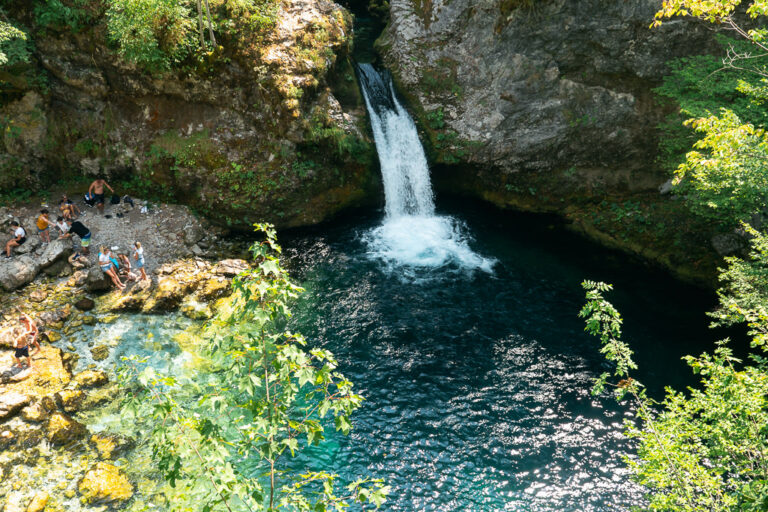
The most popular day hike goes from the mountain village Theth to Valbone. If you are looking for multi-day trekking, this area connects to the Peaks of the Balkans cross-border trail network.
Another excellent hub for hiking, rafting, and other river activities is the lesser-known town of Permet in the south, which sits at the heart of the new Vjosa Wild River National Park. This emerging ecotourism destination completely surprised me—I ended up staying longer than planned.

Here you can hike through dramatic river canyons, soak in thermal hot springs, and experience Albania’s slow food movement. Rafting is the number one activity here, though the Vjosa is gentle enough that it’s more relaxing than adrenaline-pumping. You can read a lot more in my in-depth guide to Permet.
Is Tirana worth visiting?
Albania’s capital is almost entirely modern, so some visitors looking purely for historical charm might end up skipping it.
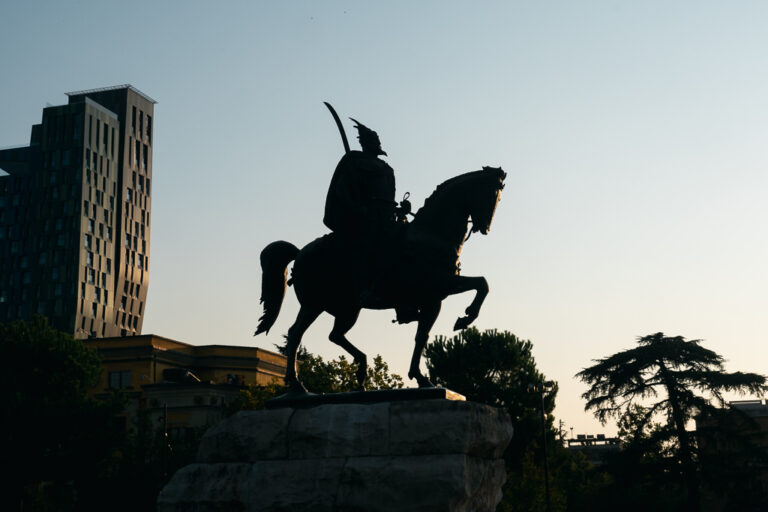
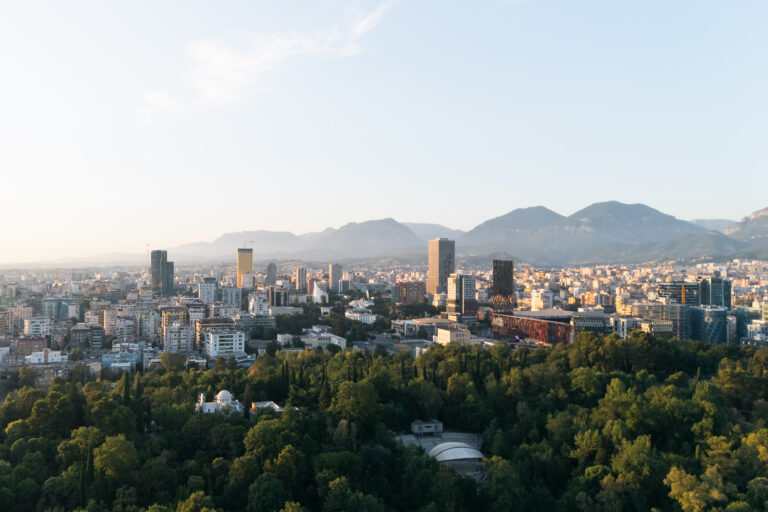
Tirana has lots of charm and creative spark—from its daringly colorful buildings to its buzzing Blokku neighborhood—making it one of my favorite Balkan capitals. It’s also the best place to learn about Albania’s dictatorship years, so if you find this interesting it deserves a proper slot in your itinerary if you have the time available.
Personally I think it’s worth spending at least a day or two in the capital — and I make the case for Tirana in this in-depth guide.
Albania itineraries
Before we get into the logistics of when to visit and how to get around, I should mention I’ve created two detailed Albania itineraries—a tight 1-week loop and a comprehensive 2-week route—that combine everything I’m covering here into actionable day-by-day plans.
If you’re ready to get into the precise travel route details you can jump over to my Albania itineraries now. Or you can open it in a second tab while we dig further into the planning logistics, budgeting, and timing here.
PS: Make sure to add the Albanian Alps Loop to your itinerary — here’s why. This route connects Shkodër, Theth, Valbonë, and Komani Lake in one breathtaking circuit through Albania’s wild north. It’s a fairly stiff hike but not extreme, just expect early mornings, some bumpy minibus rides, and nights in homestays and guesthouses.
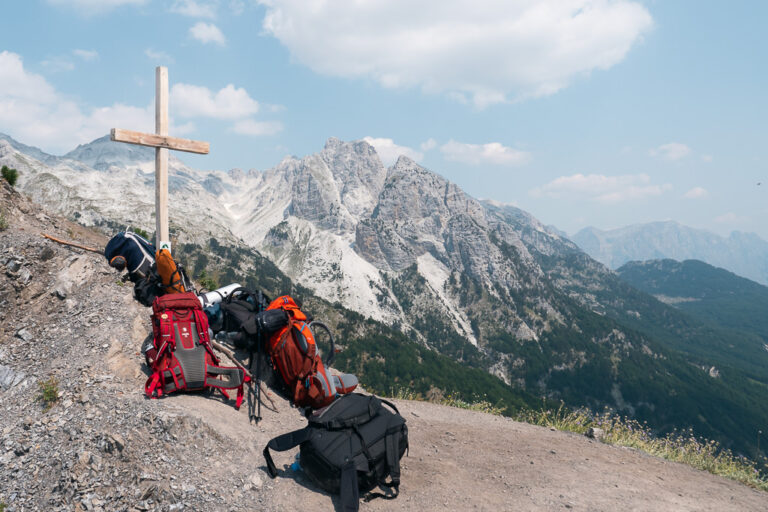
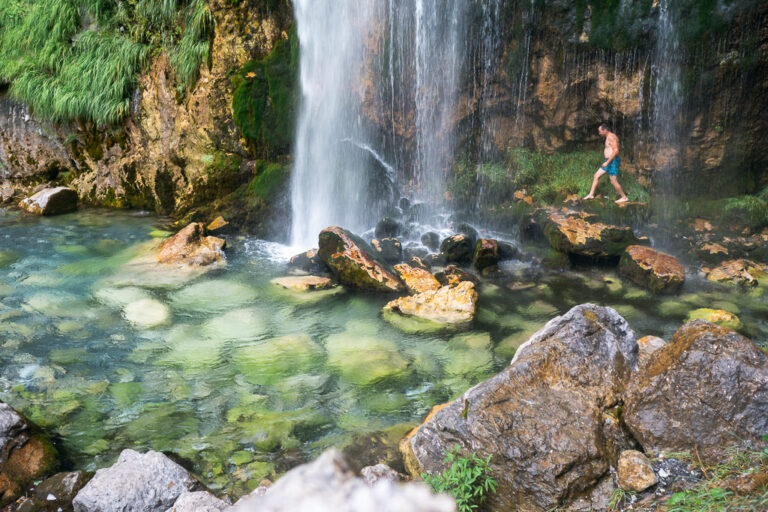
The Theth–Valbonë hike crosses a high mountain pass lined with pine forests and alpine meadows, while the Komani Lake ferry glides through winds through a canyon of towering cliffs. Once you reach the saddle between Valbonë and Theth, you’ll see the mountain you just climbed unfold from a completely different angle.
The views are epic the entire time and the loop is raw, remote, and very remarkable. You can see it all through this 3-day trip from Tirana – covering Komani Lake, Valbonë, and Theth, with boat rides, hikes, and guesthouse stays included.
When to visit Albania
Whenever I visit the Balkans, I somehow end up in the middle of a scorching heatwave. I’ve visited Albania in summer twice and both times faced temperatures regularly approaching 40C, my face often feeling like a melted candle — and forced at times to abort my exploration just to escape to a cool river or a beach.
For this reason and for a culture or nature-focused trip, my advice is to actually target spring or autumn/fall. It’s just a lot easier to, well… do stuff, when you’re not constantly sweating into a puddle. While I had some great trips in summer, next time I would try to go in May or September for a more active trip to the cities or interior.

To be fair, normal peak summer temperatures are more usually around 30/32C, which is a lot more agreeable. If your trip is mostly beach-focused, July/August are still the obvious months to target, though they’re in the typical European high season.
Flying to Albania
If you’re flying into Albania then the capital Tirana is the obvious option, but it’s far from the only one. Depending on your specific plans, it may not even be the best option. It’s worth casting a wide net and checking all the airports that might work for you.
Sometimes the best way to get into Albania is to fly to a neighboring country. Greece and Montenegro have a more established tourism industry and connect with a wider range of destinations.
Here’s an overview of recommended entry points:
- Tirana, Albania (see flights to Tirana). A somewhat small airport given it’s Albania’s capital, but it’s under expansion. It serves as the hub for budget carriers Wizzair and Air Albania. I used this airport in 2025 and it was a smooth experience. Just keep in mind traffic can often cause delays between the airport and the city center.
- Vlora, Albania (see flights to Vlora). This is the brand new international airport located in the south, beginning services in late 2025. It will become the ideal place to fly into for a beach holiday in Albania.
- Corfu, Greece (see flights to Corfu). This Greek island is highly established as a summer beach holiday destination with a plethora of flight connections from all over Europe. Take a 30-minute ferry and you’re in Sarande, Albania. While the Greek taxi drivers charge a lot for the short ride from the airport terminal to the docks (EUR20 for only about 10 minutes!), it’s a great way of getting into southern Albania.
- Podgorica, Montenegro (see flights to Podgorica). Just an hour’s drive or so from Albania’s northern city, Skodra. Ideal if you plan to visit this city or to go hiking in the Albanian Alps. Tivat Airport in Montenegro can also be a good option.
Being flexible with your entry or departure points could save you quite a bit of money. On my first trip to Albania I actually began my trip in Split, Croatia and ended in Corfu, Greece, with Albania sandwiched in between. Taking advantage of the cheapest flight options in the region saved me several hundred Euros in airfare that I could now spend during the trip itself.
You can click here to search all airports in and around Albania. While I include this search link to help with your research, I don’t recommend booking with third-party sites like Kiwi. To avoid customer service headaches, it’s best to book directly with the airline.
find all flights to albania
How to get around
Albania can be somewhat challenging if you’re not accustomed to travelling in developing countries. Expect the formal public transport system to be rather underdeveloped.
Bus stations are often barely stations at all; for instance, Tirana’s bus terminal is essentially just a parking lot without any facilities. Honestly, even a bus station in dirt-poor Bolivia is better than this.
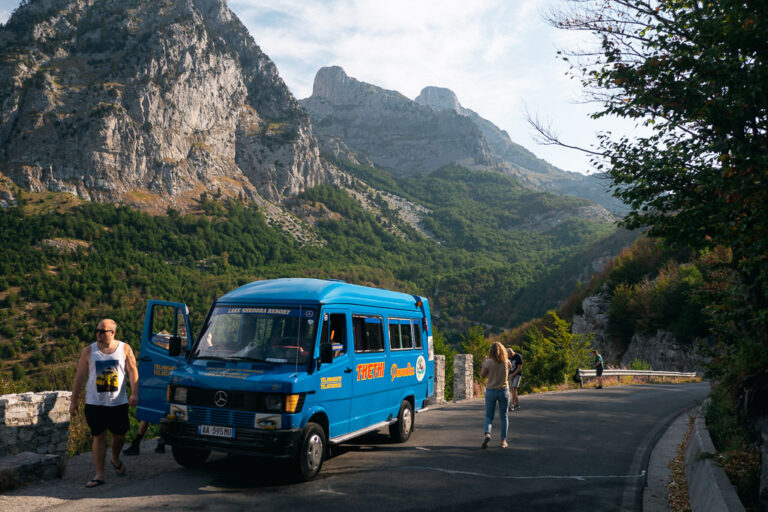
Then again, travel is easy when you consider the many unscheduled minivan services known as furgon that plow the major routes.
They are very frequent and usually not too uncomfortable. Bring some backpacker spirit and a willingness to ask a stranger for help and you’ll surely get where you want to be. Once you get into the flow of things, travelling in Albania can actually be quite easy.
Bus travel
For maximum comfort you may want to stick to just using coach bus services, which depart at set times. But if you don’t mind some potentially cramped seating, you can also travel with the local minibuses known as furgon.
Unlike in other developing countries, they luckily don’t wait around forever to leave until they’re full. The furgons seem pretty quick and goal-oriented, stopping only occasionally to drop passengers off.

Just keep these things in mind:
- Bus terminals are very bare-bones. Don’t expect any signage, information desks, or other conveniences that would make things easier for a tourist. There is often no terminal building, no timetables or screens, and no numbered bays. Bus or furgon stops outside the city are usually unmarked, so you just have to know where to wait. I strongly recommend installing the MAPS.me app which usually indicates the pickup points, or you can ask locally.
- Look for destinations shown on the windshield. Every bus or minivan will have a sign showing their final destination. Consider if your final stop might be en route: for instance, to get from Sarande to Himara, you may have to first grab a furgon to Vlora.
- It’s often easiest to just buy tickets in person. Only some buses can be booked online (usually the larger coach buses). Seats are generally unassigned so you can just sit wherever you like. You typically pay at the end when disembarking, or someone will come to you during the journey to collect your payment.
- Online timetables are not always accurate. Gjirafa travel is a site often recommended for timetables, but twice I was not able to find a bus that was listed there. Don’t bother asking AI — a severe lack of data makes them hallucinate like a mantis shrimp on acid. Hostel/guesthouse owners were always my best sources of information.
Taxis
Taxis can be helpful for shorter local trips, but they’re not quite as affordable as I expected. (I live in Portugal where taxis are actually cheaper despite having a more developed economy.)
Ride-hailing services like Uber or Bolt do not exist in Albania. The only ride-hailing option is the local Patoko, which works pretty well but only in key cities like Tirana, Vlorë, and Sarandë.
With Patoko you can either pay by card or in cash. You have to approve the ride when it’s finished, so it’s best if you have mobile data available. If not, you could still hail using WiFi and promise the driver to approve the ride as soon as you get back online, or ask them to hotspot you.
Car rental
Albania is a wonderful road trip destination. Just know that the roads around the capital are often clogged, which can lead to delays. Some of the more remote mountain roads can also be heavily potholed. Albanians can honestly be very erratic drivers as well.
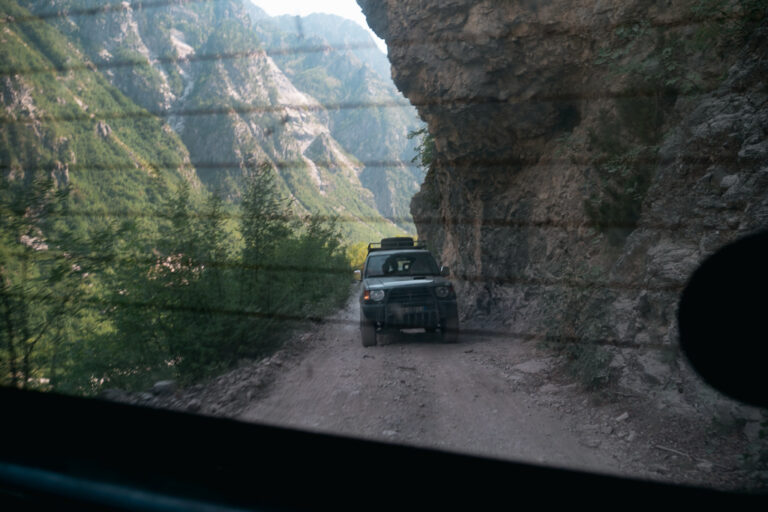
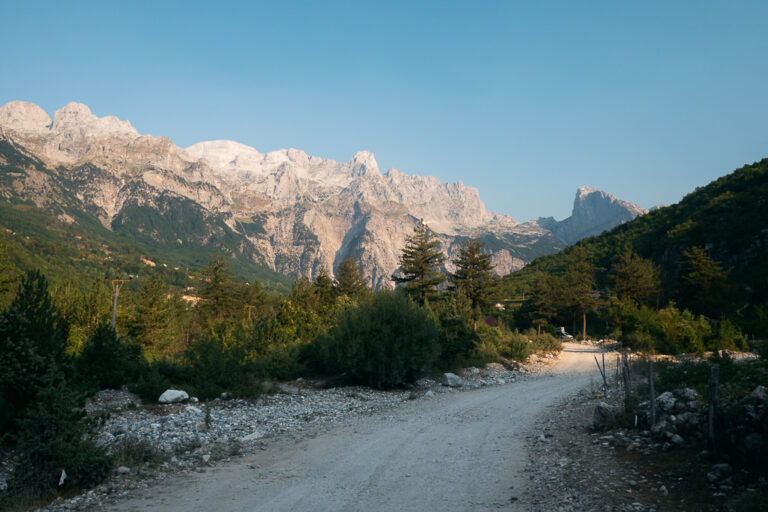
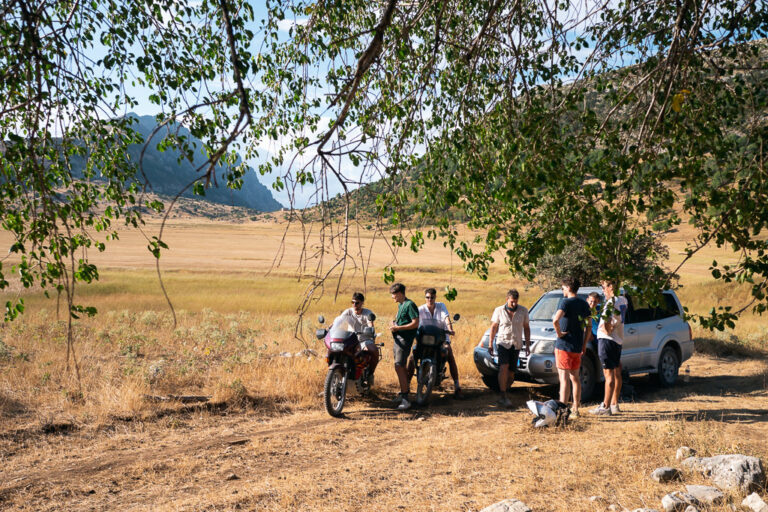
Luckily, driving around the arterial provincial roads or along the coastline is mostly pretty chill. Any car will do for the main roads, but I highly recommend a 4-wheel drive or having at least an engine with a bit of oomph if you’re going off-path or visiting small villages, since side-roads in Albania are often unpaved.
Road trip adventurists are sure to love this though and Albania is a big hit with campervanners. Albania is one of the few countries in Europe where wild camping is officially allowed.
Don’t get lost! An important map tip… Avoid using Google Maps to navigate if you’re leaving the main roads, as it is truly awful in Albania. It seems as though Google has simply not yet bothered to do a proper road survey of Albania, often you giving completely incorrect directions. Maps.me offers much more accurate detail, or you can use other OpenStreetMap-based apps.
Some final travel tips
Budgeting
Albania is very affordable compared to higher-income areas of Europe. You can get by on a backpacker budget of around 30 EUR per day per person, or 50 EUR a day as an independent traveller staying in low/midrange hotels and enjoying restaurant meals every day.
Some ideas of costs (converted from Lek to Euro):
- 3.50 EUR for a tasty burger with chips and soda in a local place
- 8 – 9 EUR for a main dish in a normal ‘tourist’ restaurant
- 6 EUR for triple-stacked pancake in a trendy cafe in Blokku, Tirana
- 1 EUR for an americano in a local place
- 4-5 EUR for a furgon minibus ride between nearby destinations (e.g., Gjirokaster to Permet in an hour)
- 14 – 15 EUR for a bus ticket from the central capital to Sarande in the south (a 5 hour journey)
Safety
What often muddles people’s idea of safety in Albania is its association with the mafia in popular culture. Does your action TV show need some more evil henchmen? Then why not crack open another barrel of burly Albanian baddies.
The stereotype is not entirely inaccurate as there actually is much organized crime in Albania, despite efforts to clean things up ahead of a potential EU membership.
Luckily it is very much an underground thing, meaning day-to-day life Albania is very safe and only normal common sense awareness is needed. In fact, crime statistics for the capital are some of the lowest in Europe. Many travellers hitchhike in Albania, which they wouldn’t do if it were dangerous.
So don’t worry, Albania is very safe for tourists. A good rule of thumb is this: if you’re comfortable travelling in Italy then you should be fine with Albania too.
Of course, as anywhere really it’s wise to secure your valuables and to avoid isolated areas at night. Statistically, road safety is a bigger issue as aggressive drivers and poor road conditions can be challenging at times. Be vigilant in traffic and you’ll be travelling Albania responsibly.
ATM fees
While you can pay contactless in many establishments, having cash on you is still a good idea, especially for paying in smaller cafes or local businesses.
Keep in mind though the Albanian ATMs, even those at commercial banks, charge quite high fees of at least 6 to 8 EUR per transaction.
It depends on your specific bank card, but I got some of the lowest fees with Union Bank. The app ATMFeeSaver can be very helpful.
I hope this in-depth guide has inspired you to explore Albania! Want to dive deeper? Then the next step is to check out my 2 tailored itineraries for Albania for 1 or 2 weeks, or check our other Albania guides below.
www.indietraveller.co (Article Sourced Website)
#Albania #Travel #Guide #Tips
